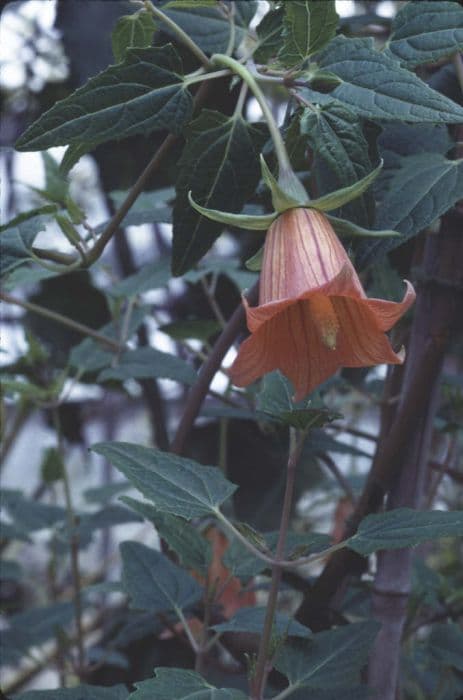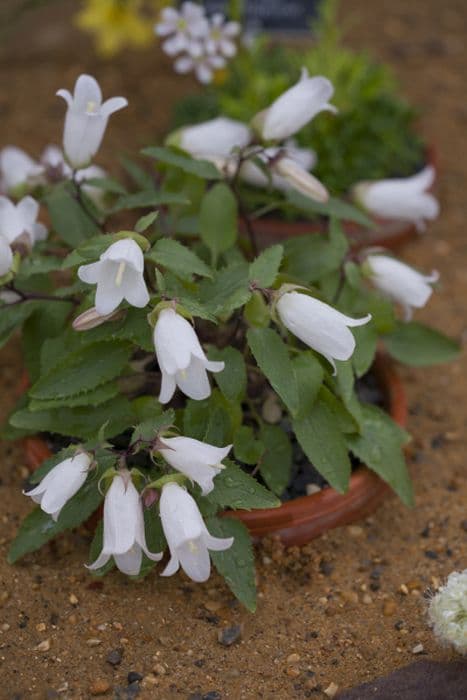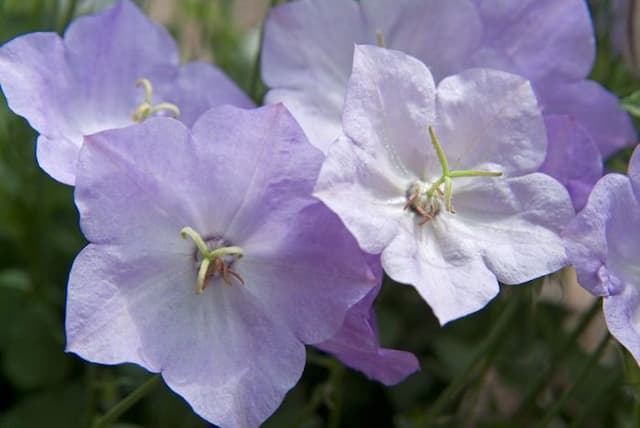Canary Bellflower Canarina canariensis

ABOUT
The Canary Bellflower is a captivating plant that boasts a unique and striking appearance. It is adorned with large, bell-shaped flowers that are typically a deep orange to red hue, with fine, delicate hairs lining the petals. The interior of the flowers often exhibits a subtle pattern of darker red or maroon spots, which stand out against the orange backdrop. These beautiful blooms dangle elegantly from the stems, adding to their allure. The plant's foliage is equally attractive, characterized by heart-shaped leaves which are a lush green shade, providing a rich contrast to the vibrant color of the flowers. The leaves can have subtle serrations on the edges, giving them a slight ruffled look that complements the overall aesthetics of the plant. The stems are sturdy, and the plant tends to produce a climbing or scrambling habit, reaching out to support itself on nearby structures or other vegetation. In addition to its ornamental charm, the Canary Bellflower produces a fruity fragrance that may attract pollinators, as well as humans who are lucky enough to be within the vicinity of this beautiful specimen. It is a species that truly embodies the exotic beauty of the region it originates from, adding an element of wild allure to any setting in which it is placed.
About this plant
 Names
NamesFamily
Campanulaceae
Synonyms
Canary Bellflower, Canary Island Bellflower
Common names
Campanula canariensis, Canaria campanula
 Toxicity
ToxicityTo humans
Canarina canariensis, commonly known as the Canary Bellflower, has no well-documented evidence of toxicity to humans. However, as with any plant, some individuals may have sensitivities or allergic reactions. It is always best to avoid ingesting plants unless they are known to be safe and are prepared correctly. If any part of the Canary Bellflower is ingested and symptoms of poisoning occur, it is essential to seek medical attention.
To pets
The Canary Bellflower, or Canarina canariensis, does not have a specific toxicity profile for pets such as cats and dogs. However, the lack of information means that caution is advised. Pets should not be allowed to ingest this or any unknown plants. If a pet does consume any part of the Canary Bellflower and exhibits symptoms of poisoning, such as vomiting, diarrhea, drooling, or lethargy, contact a veterinarian immediately.
 Characteristics
CharacteristicsLife cycle
Perennials
Foliage type
Deciduous
Color of leaves
Green
Flower color
Orange
Height
6 feet (1.8 meters)
Spread
6 feet (1.8 meters)
Plant type
Herb
Hardiness zones
9
Native area
Canary Islands
Benefits
 General Benefits
General Benefits- Ornamental Appeal: Canarina canariensis, also known as Canary Bellflower, adds aesthetic value to gardens with its vibrant orange bell-shaped flowers.
- Habitat Enhancement: It provides natural habitat and food for pollinators such as bees and birds, contributing to biodiversity.
- Erosion Control: The plant's root system can help stabilize soil and prevent erosion on slopes or in areas prone to land degradation.
- Shade Offering: With its climbing habit, Canary Bellflower can be grown over trellises or arbors to provide shade in garden settings.
- Cultural Significance: It holds a special place in the native flora of the Canary Islands and can be used in cultural and educational settings to represent the region's biodiversity.
 Medical Properties
Medical Properties- Anti-inflammatory: Canarina canariensis has been traditionally used to reduce inflammation.
- Diuretic: The plant is said to possess diuretic properties which could help in increasing the passing of urine.
- Emmenagogue: There is some evidence that suggests the plant might have properties that stimulate menstrual flow.
 Air-purifying Qualities
Air-purifying QualitiesThis plant is not specifically known for air purifying qualities.
 Other Uses
Other Uses- Canarina, due to its vibrant bell-shaped flowers, can be used as a natural dye for fabrics, giving them a soft yellow to green hue depending on the mordant used.
- The stems of Canarina can be woven into small decorative items or used in creating intricate patterns in basketry owing to their flexibility when young.
- Its succulent leaves, while not commonly eaten, have been occasionally used as a supplemental forage for livestock in its native habitat.
- The plant can serve educational purposes such as in botany classes demonstrating the characteristics of the Campanulaceae family.
- Canarina seeds are sometimes used in jewelry making as beads, particularly by crafters who value organic and natural materials.
- The plant's thick, tuberous roots have been carved into small whimsical figures or stamps by local artisans.
- Canarina blooms can be pressed and included in craft projects, like homemade greeting cards or bookmarks, providing a delicate touch of nature.
- It is used as a component in perfumery, particularly in small-batch and artisanal fragrance creations, to impart a subtle floral note.
- The hollow stems of the Canarina canariensis can be used in miniature model making, serving as natural pipes or tunnels.
- Photographers and painters may utilize Canarina as an attractive subject or background flora in their compositions for its aesthetic appeal.
Interesting Facts
 Feng Shui
Feng ShuiThe Canary Bellflower is not used in Feng Shui practice.
 Zodiac Sign Compitability
Zodiac Sign CompitabilityThe Canary Bellflower is not used in astrology practice.
 Plant Symbolism
Plant Symbolism- Uniqueness: Canarina canariensis, also known as the Canary Bellflower, is a unique plant native to the Canary Islands; its distinct appearance symbolizes the beauty of being unique or standing out.
- Isolation: Due to its origin on remote islands, the Canary Bellflower can represent isolation or rarity, reflecting on the uniqueness of individuals or experiences that are not commonly encountered.
- Survival: The ability of the Canary Bellflower to grow in the volcanic soils of the Canary Islands symbolizes resilience and the capacity to thrive amidst challenging conditions.
 Water
WaterThe Canary Bellflower should be watered thoroughly, allowing the top inch of the soil to dry out between waterings, which typically means watering once a week. During its active growth period in fall and winter, it may require slightly more frequent watering, perhaps every 5 to 6 days. It's better to water this plant with a gentle soak, either from below or by directing water at the base rather than overhead watering, which can damage the flowers. An average-sized plant in a pot of approximately 6-8 inches in diameter might require about 16 to 24 ounces per watering. During dormancy in the summer, reduce watering significantly, providing just enough to prevent the soil from becoming bone dry.
 Light
LightThe Canary Bellflower thrives best in bright, indirect light or partial shade. A north-facing or east-facing windowsill is an ideal spot for this plant, as it will be protected from the harsh afternoon sun. Ensure that it's shielded from direct sunlight, which can scorch the leaves and fade the flowers.
 Temperature
TemperatureThe Canary Bellflower prefers cool to moderate temperatures, ideally between 50 and 70 degrees Fahrenheit. It can survive short periods down to about 40 degrees but should be protected from frost and not be exposed to temperatures below freezing. The maximum temperature this plant tolerates well is around 80 degrees, beyond which it may exhibit signs of stress.
 Pruning
PruningThe Canary Bellflower benefits from pruning to remove spent flowers and any dead or damaged foliage, which helps encourage more blooms and maintains the plant's shape. Pruning is best done following the blooming period in late winter or early spring. It is not necessary to prune this plant frequently; once a year is typically sufficient.
 Cleaning
CleaningAs needed
 Soil
SoilCanary Bellflower thrives in well-draining soil with high organic matter content; mix equal parts of peat, pine bark, and perlite for optimum growth. The ideal soil pH for Canary Bellflower is slightly acidic to neutral, ranging from pH 6.0 to 7.0.
 Repotting
RepottingCanary Bellflower should be repotted every two to three years or when it has outgrown its current pot, typically at the end of its dormancy period which is in late winter or early spring.
 Humidity & Misting
Humidity & MistingCanary Bellflower prefers high humidity levels, ideally between 60% to 70%, which mimics its natural habitat in the Canary Islands; regular misting can help maintain these conditions.
 Suitable locations
Suitable locationsIndoor
Place Canary Bellflower in bright, indirect light and ensure high humidity.
Outdoor
Grow Canary Bellflower in partial shade with shelter from intense sun.
Hardiness zone
9-11 USDA
 Life cycle
Life cycleCanarina canariensis, commonly known as the Canary Bellflower, begins its life as a seed, which, when conditions are favorable (typically in moist and shady environments), germinates to give rise to a small seedling. The seedling grows into a herbaceous plant, developing a tuberous root system which allows it to survive adverse conditions. It progresses through a vegetative stage where it develops stems, leaves, and tendrils, photosynthesizing to gain the energy needed for growth and reproduction. As the plant matures, it enters the flowering stage, typically during the cooler, moist winter months, producing striking bell-shaped orange to red flowers that attract pollinators. After successful pollination, the flowers develop into capsules containing numerous seeds, which are then dispersed by gravity and animals. The Canary Bellflower may enter a dormant phase during dry or hot periods, relying on its tuberous roots for survival until favorable conditions return.
 Propogation
PropogationPropogation time
Spring to Summer
Propogation: The Canary Bellflower, known botanically as Canarina canariensis, is typically propagated through its seeds. The best time to sow the seeds is in the fall, just after they have matured and been collected. To propagate by seed, fill a pot with a well-draining soil mix, ideally one that is rich in organic matter. The seeds should be evenly spaced on the soil surface and lightly covered with a thin layer of soil, no more than 1/4 inch (about 6 mm) deep. The pot should be placed in a warm location with indirect light and kept moist. Germination can take several weeks, so patience is required. As the seedlings grow and become large enough to handle, they can be transplanted into individual pots to continue their development.









